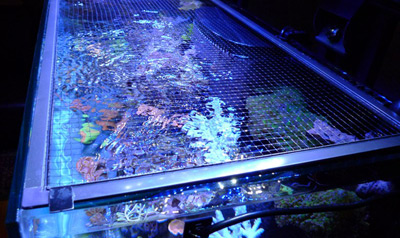Take away their trampolines, of course!
Okay, being serious now, far too many marine fish are lost unnecessarily when they leap from their tank and become “carpet jerky.” While jumping is among the most common (if not the most common) causes of aquarium fish death, it’s also the most easily avoided.
Remember, all fish can and will jump under certain circumstances—and some elevate it to an art form. This behavior is most common right after a fish has been introduced to an aquarium, but it can happen at any time. So, just as new human parents must take steps to “baby proof” their home, marine aquarium hobbyists bear the responsibility of mitigating the risk of their fish leaping into the dusty abyss.
Here are some simple tips that will help keep your fish in the tank where they belong:
Put a lid on it
We’ll start with the most obvious solution first. Completely covering the top of the tank (keeping in mind that even small openings can serve as a point of egress for some fish) is the surest way to keep your valued specimens from jumping out. However, solid glass or acrylic tank covers, while very effective fish retainers, are not without their drawbacks. Many reefkeepers eschew them because they can limit light penetration and vital gas exchange while trapping heat. A good alternative is to use mesh and window screen framing material to make a cover that will prevent fish from jumping while allowing good airflow and light penetration at the surface.
I should also point out that a tank cover addresses only the symptom of fish jumping, not the cause, which may be something that needs to be remedied just as urgently. The remaining points address these potential underlying causes.
Choose compatible tankmates
Fish will commonly leap above the water’s surface in an effort to evade a pursuing predator or bully. It’s also not uncommon for the fish giving chase to break the surface while in hot pursuit. When this happens in nature, the leaping fish is virtually certain to land back in the water (barring predatory birds and such lurking above the surface, that is), not on a dry floor.
The takeaway here is that selecting fish that are compatible with one another and observing proper order of introduction (from least aggressive to most aggressive) will go a long way toward preventing fish from jumping to their doom.
Maintain good, stable water parameters
Just as fish will leap to avoid predation or aggression, they’ll also jump to reach “greener pastures” with respect to water conditions. Again, they don’t understand that there’s only air, not water, beyond the panes of their glass or acrylic houses.
Provide ample hiding places
When fish have a good selection of nooks, crannies, and hidey holes to choose from, they tend to be more tranquil and less prone to jumping. Make sure your live rock aquascaping is arranged in a nice honeycomb fashion so refuge is always close at hand in case a fish feels bullied or threatened.
Limit sound and fury outside the tank
While some regular human activity outside the tank is desirable so the fish become acclimated to your presence and don’t panic every time you approach, highly boisterous behavior and/or excessive vibrations, such as kids “chasing” the fish around the tank or banging on the glass (or a deep, sustained booming noise prior to 9:00 a.m.), will put the fish on edge and in a jumping mood.
Provide dusk and dawn periods
At no time are fish in the ocean subjected to a sudden switch from light to total darkness or vice versa. Either scenario occurring in your tank can cause your fish to startle and jump. If possible, time your lighting system so there’s a gradual transition from light to dark in the evening and from dark to light in the morning to replicate natural dusk and dawn periods. Also, try to avoid suddenly turning on room lights after the tank has been in total darkness.



